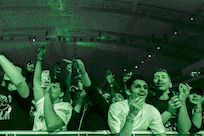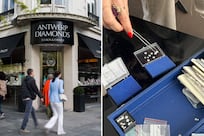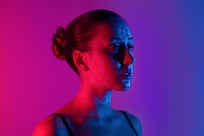It is midmorning, and the only sound in the shaded alleyways and high courtyards of Dubai's heritage quarter, Al Bastakiya, is the twittering of the birds.
Yet beyond this warren of mud, coral and concrete lie the noisy sprawl of Bur Dubai and the waterbound traffic on the city's Creek. It seems strange that the oldest section of the city is also its quietest.
Magdi Mostafa is one of three international artists currently holed up in a traditional house in Bastakiya, which offers a neutral space to reflect on the aural cacophony beyond the district.
"There's a sound of economy in this city," says Mostafa, who works with sound and is pushing to get such experimental art styles better accepted back home in Egypt. "The noise of the mall, of the heat. You feel the voltage and electricity in the streets, as there are few clean power sources, oil is constantly being burnt to power it all. These elements build into a distinct sound sketch."
Joining Mostafa in Bastakiya's House 44 are Deniz Üster and Fayçal Baghriche, from Turkey and Algeria respectively. They are working side by side with the prominent Emirati artists Zeinab Al Hashemi, Hadeyeh Badri and Nasir Nasrallah as part of a residency programme that continues until next month, when both Art Dubai and, in the traditional houses of the Bastakiya, the Sikka Art Fair open.
"Bastakiya is the heart of Dubai's cultural identity, a destination for people to discuss and share ideas," says Khalil Abdulwahid, the manager of visual arts for the Dubai Culture and Arts Authority (DCAA), the body that administers the heritage quarter.
"We are trying to build on this by forging connections between local and international artists."
The individual results of this three-month programme will be exhibited in March; one project at Art Dubai and the other in Bastakiya, when the artists will also open up their studios to the public.
For the project, the DCAA has partnered with Tashkeel, Art Dubai and the Delfina Foundation, which hosts numerous artist residencies throughout the year in London.
Aaron Cezar, the director of Delfina, insists on the positive impact that artist residencies can have on a city and its art scene: "I think it offers the locale a new way of thinking by bringing in an outside perspective."
This is the second time the city has collaborated with Delfina to create such a residency, which has expanded this year from five to six artists.
Cezar was in Dubai in January, and says that he spent a lot of his time working closely with the Emirati artists.
"I'm telling them to look at every part of the creative process," he says. "If they're sourcing a certain material for their work, I'm telling them to talk to the person they're sourcing it from, to look at all the strands and narratives that go into the creation of an artwork."
The process has already made an impression on Al Hashemi, a Dubai-born artist who has exhibited in the city's Ara Gallery and whose previous work included a digitally wrought skyline composed of dirham notes.
"I'm at a stage where I want to have a deeper understanding of the art I'm producing," says Al Hashemi. "I've relied on the computer before to create my work as that was the only techniques that I'd studied. But meeting these artists has pushed me to mix that up, and I'm incorporating elements into my work that make use of machinery like the circular saw and laser-cutter."
The artist says she was invited to take part in a residency programme abroad last year, but had to turn it down: "I didn't feel confident enough. I think this is a good chance now for us to prepare for residency programmes in other countries."
Cezar's research focus has also been important to Badri, who participated in last year's Emirati Expressions workshop series with the American photographer Stephen Shore. After creating work last year that looked at cramped interiors and rooms around the city, Badri is now taking a more expansive approach - searching out landscapes that have greater room to breathe.
For the international artists, the city presents some unique references on their own work. Baghriche has previously exhibited at the Venice Biennale, and creates concept-driven pieces that question the once-assumed fixedness of national identity and rootedness. He describes the meeting of nationalities found in the city as an inspiration.
Üster echoes this sentiment: "For the first two weeks I just walked around Dubai in amazement," says the artist, originally from Istanbul. "I'm inspired by cities like this that really grasp their history - those that have hits and crashes - rather than being frozen in a certain way."
Üster has been working on a wood-based sculpture for the March show that, she says, will be a "vagrant wind tower", taking visual cues from the rooftop cooling chambers that adorn the old houses of Bastakiya but distorted and distanced from a context specific to the UAE.
The Sharjah-based painter and collagist Nasrallah has to balance his residency with a full-time job. So, in part, the decision to bring a curator-in-residence to work with the group is to ensure that the conduits of exchange between artists - international and local - are successful. Alexandra MacGilp, who has previously curated shows in London, Hamburg and Kabul, is staying with the group in Bastakiya throughout. "Artists can be quite single-minded, and need to be brought together," she says, and is organising regular discussions among the group to bring more of an art-school, academic structure to the conversations and exchange that are at the centre of a residency like this.
Should the 2012 programme prove a success, it's a good sign for the future of Bastakiya. As the city's art scene drifted into the industrial ramparts of Al Quoz and the Dubai International Financial Centre (XVA Gallery moved its commercial art space from Bastakiya into DIFC last year), this once city-centre art hub has seemed a bit shut out.
But Salem Belyouha, the projects and events director at the DCAA, says the authority is developing a space to host artists throughout the year. "We've already allocated two houses to create a huge facility that will be a permanent house of residency," he says. "It will take six to eight months for the maintenance to be completed, after which we'll have 11 working studios in House 16.
"Our plan is to work with cultural attachés from the UK and France at first. We want to open a programme of exchange channels with other countries - sending artists from here abroad, and bringing international artists to Dubai."
With more foot traffic passing through the area, helped along by both the Emirates Airline Festival of Literature moving its HQ to one of the houses recently and the Sikka Art Fair next month, Bastakiya might soon play a greater part in the fabric of Dubai's contemporary art scene, and not just be a quiet monument to the city's past.
Work by the six artists will be displayed in Art Dubai from March 21-24 and in the Sikka Art Fair from March 15-25, during a fortnight of music and commissioned art projects taking place across the Bastakiya area
Follow us on Twitter and keep up to date with the latest in arts and lifestyle news at twitter.com/LifeNationalUAE





